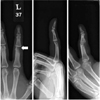Abstract
Osteochondral injury due to the trauma of the hand is relatively common. If the size of the osteochondral fracture fragment is large, open reduction and internal fixation are often feasible in treating these problems. However, arthroplasty using osteochondral graft is more preferred when the particle is small and articular surface is comminuted or fully defected. There are many reports of osteochondral graft using the costal osteochondral graft but the osteochondral graft using the interphalangeal joint of the toe is rarely reported. Thoroughly reviewed with relevant articles, this report presents a case of a 33 year old male who was successfully treated with osteochondral autograft using the proximal interphalangeal joint of the toe due to the traumatic osteochondral defect in the head of the second proximal phalanx.
Figures and Tables
Fig. 1
Anteroposterior, oblique and lateral roentgenograms show bone defect on left second proximal phalangeal head (The arrow shows a osteochondral defect more than half of ulnar side in proximal phalangeal head of the left second finger).

Fig. 2
The head proximal phalanx was resected and proximal interphalangeal joint of left 5th toe was fixed with 2 K-wires.

References
1. Allende BT, Engelem JC. Tension-band arthrodesis in the finger joints. J Hand Surg Am. 1980. 5:269–271.

2. Boulas HJ, Herren A, Büchler U. Osteochondral metatarsophalangeal autografts for traumatic articular metacarpophalangeal defects: a preliminary report. J Hand Surg Am. 1993. 18:1086–1092.

3. Capo JT, Hasting H 2nd, Choung E, Kinchelow T, Rossy W, Steinberg B. Hemicondylar hamate replacement arthroplasty for proximal interphalangeal joint fracture dislocation: an assessment of graft suitability. J Hand Surg Am. 2008. 33:733–739.

4. Carroll RE, Taber TH. Digital arthroplasty of the proximal interphalangeal joint. J Bone Joint Surg Am. 1954. 36-A:912–920.

5. Chung DW, Han CS, Song YS. Hand joint reconstruction with rib osteochondral graft. J Korean Soc Surg Hand. 1996. 1:45–51.
6. Ellis PR, Tsai TM. Management of the traumatized joint of the finger. Clin Plast Surg. 1989. 16:457–473.

7. Hasegawa T, Yamano Y. Arthroplasty of the proximal interphalangeal joint using costal cartilage grafts. J Hand Surg Br. 1992. 17:583–585.

8. Ishida O, Ikuta Y, Kuroki H. Ipsilateral osteochondral grafting for finger joint repair. J Hand Surg Am. 1994. 19:372–377.

10. McElfresh EC, Dobyns JH. Intra-articular metacarpal head fractures. J Hand Surg Am. 1983. 8:383–393.

11. Seradge H, Kutz JA, Klinert HE, Lister GD, Wolff TW, Atasoy E. Perichondrial resurfacing arthroplasty in the hand. J Hand Surg Am. 1984. 9:880–886.

12. Skoog T, Johansson SH. The formation of articular cartilage from free perichondrial grafts. Plast Reconstr Surg. 1976. 57:1–6.




 PDF
PDF ePub
ePub Citation
Citation Print
Print




 XML Download
XML Download